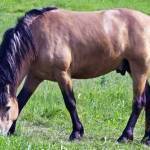Developmental Orthopedic Disease in Foals: An Overview

Developmental orthopedic disease (DOD) is a collective term for abnormal growth conditions in young foals. DOD is usually caused by one or a combination of three factors: genetics, imbalanced diet, and excessive intake of calories causing too-rapid growth. Traumatic injury, malpositioning in the womb, or overexercise can also cause or contribute to DOD. When breeding horses, it is important to consider that DOD can be heritable, and knowing how other offspring from the sire and dam, if available, fared can be useful for determining future pairings.
According to the Merck Veterinary Manual, DOD can include:
- Osteochondritis dissecans: a bone fragment resulting from abnormal cartilage growth. Signs may include joint stiffness, swelling, lying down more than normal, pain upon joint flexion, or varying degrees of lameness. Some cases resolve spontaneously; others require surgery. Unresolved cases can lead to arthritis as horses age.
- Physitis: swelling of the growth plates of long bones, often associated with rapid growth, obesity, conformational defects, and overexercise.
- Contracted tendons: may be present at birth due to abnormal positioning in the uterus or genetics, or can be acquired from pain, abnormal locomotion, or too-rapid growth. The foal may appear to be standing on its toes.
- Scapulohumeral dysplasia: abnormal shoulder development in ponies and miniature horses, causing instability and arthritis. This condition may not manifest until adulthood.+
Nutrition plays an important part in tissue development and growth. Foals are dependent on the mare’s milk for the first three months of life. During this time, the digestive tract is too immature to digest grains or fiber, even though the foal may be curious to try the dam’s feed. Around the fourth month of lactation, the quantity of nutrients in the mare’s milk naturally declines and the foal begins to sample forages and concentrates. A “creep feed” specifically designed for growing foals is usually recommended, as these are typically formulated with higher concentrations of essential amino acids and other nutrients specifically designed to support healthy growth. Introducing the foal to the types of forages and concentrates at least one month before weaning will help the digestive tract adjust to the new diet and reduce stress at weaning time.
After weaning, the foal is completely dependent on forage and supplemental feed. The young horse grows the most rapidly between the ages of 6-18 months, so this phase of life is especially critical for balanced nutrition.
According to Catherine Whitehouse, M.S., a nutritionist at Kentucky Equine Research, “During this period of a young horse’s life, it is important to try and maintain steady growth rates and avoid major slowdowns or growth spurts. Compensatory rapid growth is a risk factor for DOD.”
Keep in mind that in the spring and fall, pastures tend to be nutrient-rich and can promote rapid growth. Monitoring pasture intake, and possibly substituting with dry forages, during these seasons is good practice to help maintain a steadier growth rate.
A myth swirls among some old-timers, one that blames excess dietary protein for DOD. Multiple studies have disproved that theory. According to the National Research Council (NRC) Nutrient Requirements of Horses (2007), high-protein diets do not appear to influence the occurrence of DOD. Foals fed 126% of NRC recommendations of crude protein did not develop abnormal cartilage around the joints.* The addition of the essential amino acid lysine or a combination of lysine and threonine did not affect bone mineral content or skeletal growth rates.**
If swelling, pain, or lameness presents itself, the first thing to do is contact a veterinarian for a diagnosis and a treatment plan. When it comes to nutrition, in some cases, it may be necessary to reduce calorie intake, but it is imperative not to reduce vitamin and mineral intake. Careful balance of essential minerals—for example, calcium and phosphorus—is particularly critical for bone and tissue development. Eliminating or reducing these nutrients is not recommended. To maintain proper nutrient intake without supplying excess energy in the diet, use a ration balancer. Work with your veterinarian to identify the cause and treatment of any potential DOD, and a nutritionist to help create a well-balanced diet to support the growing horse in the healthiest way possible.
In summary, it is important to ensure a balanced diet that does not oversupply calories. When it comes to DOD, nutrition is certainly not the only factor, but it is significantly important for supporting normal growth. Ensuring proper energy intake and nutrient balance is the foundation for setting up a young horse for a strong future. If a foal shows any signs of swelling in the joints, lameness, discomfort, or abnormal limb alignment, involve the veterinarian immediately so a diagnosis and treatment plan can be put in place immediately.
+Merck Veterinary Manual. 2024. Developmental orthopedic diseases in horses. Accessed April 2024.
*Savage, C.J., R.N. McCarthy, and L.B. Jeffcott. 1993. Effects of dietary energy and protein on induction of dyschondroplasia in foals. Equine Veterinary Journal 16:74-79.
**Graham, P.M., E.A. Ott, J.H. Brendemuhl, et al. 1994. The effect of supplemental lysine and threonine on growth and development of yearling horses. Journal of Animal Science 72:380-386.







